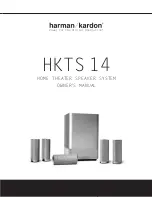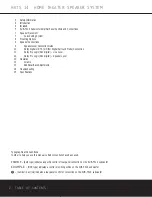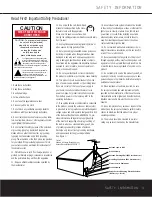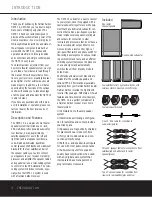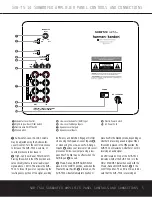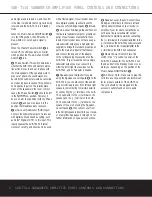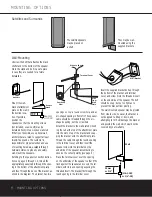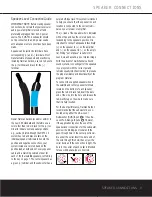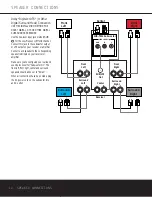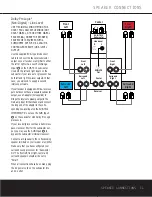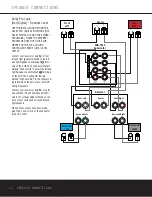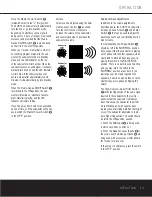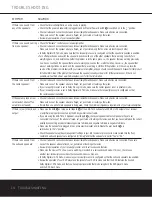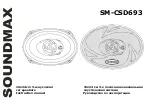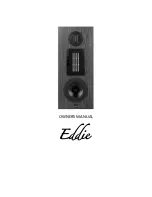
6
SUB-TS14 SUBWOOFER AMPLIFIER PANEL CONTROLS AND CONNECTIONS
SUB-TS14 SUBWOOFER AMPLIFIER PANEL CONTROLS AND CONNECTIONS
audio signal and is turned on, and the LED
is lit amber to indicate that no signal is being
received and the SUB-TS14 is in Standby
mode.
When the
Music-Sense On/Off Switch
£
is in the
ON
position, the LED will be lit
blue, whether or not an audio signal is
present.
When the
Master Power Switch
ª
is
turned off, the LED goes dark, no matter
which position the
Music-Sense On/Off
Switch
£
is in.
¢
Phase Switch:
This switch determines
whether the SUB-TS14 subwoofer’s piston-
like action moves in and out in phase with
the main speakers. If the speakers were to
play out of phase, the sound waves pro-
duced by the subwoofer would be cancelled
out, reducing bass response. This phenome-
non depends in part on the relative place-
ment of the speakers in the room. In most
cases, the
Phase Switch
¢
should be left
in the
NORMAL
position. However, it
does no harm to experiment with the
Phase
Switch
¢
, and you may leave it in the
position that maximizes bass response.
∞
Line-Level Subwoofer (SUB) Input:
Connect the subwoofer output of a receiver
with digital surround sound decoding, such
as Dolby* Digital or DTS
®
, to this input. This
input bypasses the SUB-TS14’s internal
crossover circuitry, and should only be used
with a filtered signal. If your receiver does not
have digital decoding, you should use the
Line-Level Full-Range Inputs
§
instead.
§
Line-Level Full-Range Inputs:
Connect
the line-level subwoofer output or preamp out-
put(s) of your receiver or amplifier to these
inputs. If your receiver does not have a sepa-
rate subwoofer output, use a Y-adaptor (not
supplied) to bridge the receiver’s preamp out-
put to the main amp input for that channel,
and connect the long end of the adaptor
to the corresponding line-level input on the
SUB-TS14. If your receiver has only a single
subwoofer output, you may connect it to
either the left or right line-level input on the
SUB-TS14, and no Y-adaptor is needed.
¶
Speaker-Level Outputs:
If you are
using the
Speaker-Level Inputs
•
on the
SUB-TS14, you should connect these bind-
ing post terminals to your front left and right
speakers, remembering to maintain polarity
by connecting the (+) terminal on the SUB-
TS14 subwoofer to the (+) terminal on the
speaker, and the (–) terminal on the SUB-
TS14 subwoofer to the (–) terminal on the
speaker. If you are not using the
Speaker-
Level Inputs
•
, then connect your front
left and right speakers directly to your receiv-
er or amplifier. See pages 9 through 12 for
further information on speaker connections.
•
Speaker-Level Inputs:
Connect these
binding-post terminals to the main left and
right speaker terminals of your receiver or
amplifier, if your receiver or amplifier does
not have a line-level subwoofer output.
Remember to maintain polarity by connecting
the (+) terminal on the receiver/amplifier to the
(+) terminal on the SUB-TS14 subwoofer, and
the (–) terminal on the receiver/amplifier to the
(–) terminal on the SUB-TS14 subwoofer.
ª
Master Power Switch:
Place this
switch in the “•” position to power-on the
SUB-TS14 subwoofer. The SUB-TS14 will
then be either in the Standby mode or com-
pletely on, depending on the position of the
Music-Sense On/Off Switch
£
.
‚
AC Power Cord:
Make sure to plug this
cord into an active, unswitched electrical out-
let for proper operation of the SUB-TS14.
The cord should not be plugged into the
accessory outlets found on some audio
components.
HKTS 14 OM 11/4/03 11:32 AM Page 8

